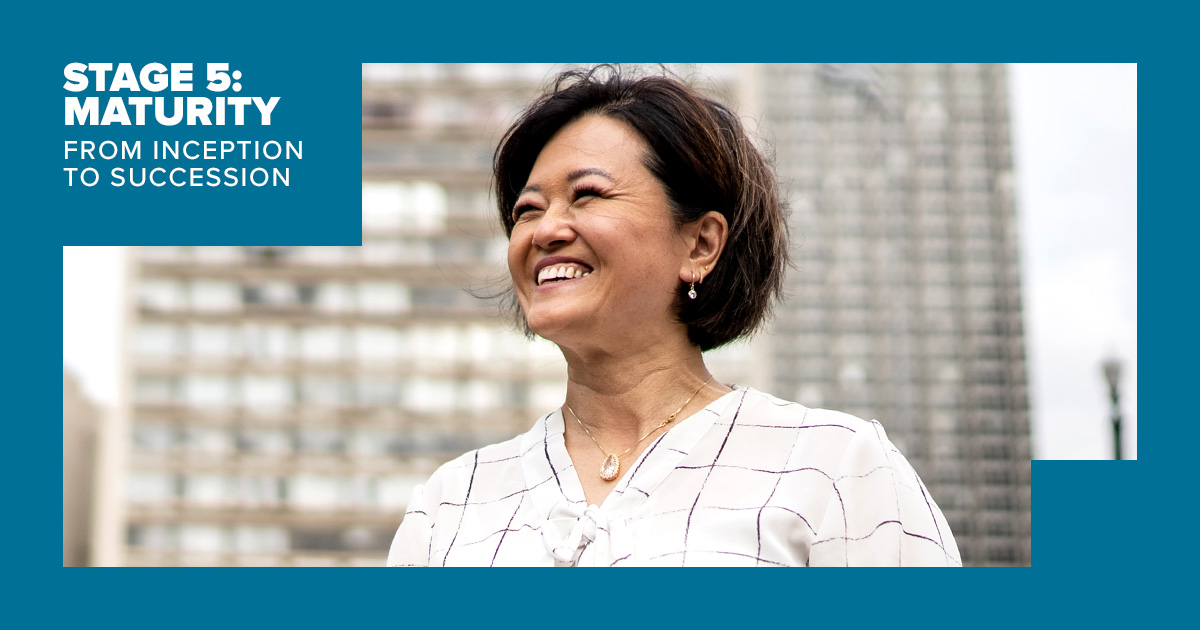Non-Deposit Investment Products: • Are Not FDIC Insured • Are Not Bank Guaranteed • May Lose Value
As a bank founded on the entrepreneurial spirit, women business owners are a group that City National Bank is especially passionate about supporting. Breaking down the barriers that limit women's ability to prosper as independent business owners is critical to our collective economic future. That's why we undertook a research initiative to better understand the experiences of women entrepreneurs.
This article is adapted from a portion of that report. Download the complete report or read more articles based on it here.
When they reach the growth stage, women-owned businesses have steady profits, loyal customers and well-established operations. But the owners see potential for so much more. This stage will look different for every business.
During this stage businesses may:
- Hire employees.
- Expand into new locations.
- Develop new products.
- Add digital capabilities.
However, any expansion comes with decisions that need to be made about the priorities and purpose of the business.
Questions that women business owners need to answer during expansion include:
- How much, or how little, are you willing to compromise on product quality, profits or work culture to pursue growth?
- How do you view the ideal growth pattern for your business – steady and predictable growth or sudden growth?
- What does growth mean for women business owners and their companies?
Four Ways to Look at Business Growth
Business owners look at growth in many different ways, but here are four common themes found around how businesses, and the women entrepreneurs behind them, look at growth:
Profitability
Some owners focus on profitability first, seeking to maximize income from operations before expanding with new locations or hiring. These women business owners show interest in learning more about how to make annual profit projections, improve profit margins, and streamline their businesses.
Organizational Growth
Others aim for organizational growth. They understand that adding employees or customers or locations may require them to rethink their businesses, and add new tools to manage staff or a network of customers and vendors.
Internal Growth
A third group put a premium on internal growth. These women business owners want to help their employees learn and grow with carefully chosen benefits, training and a culture that supports personal growth. Many of these entrepreneurs told us they wanted to hire more people to strengthen and build their staff. They were looking for a way to delegate some of their work to employees so that they could focus on building their companies.
Personal Growth
Among all the focus on the business and its success, personal growth is also something that many women entrepreneurs start to really value at this stage. They have come a long way from having the idea that sparked their business ownership journey. After years of working hard, learning and growing their business, looking back on how that experience has changed them over time can be a very rewarding process.
Regardless of what growth means to your business, this stage is all about dreaming big and taking the concrete steps that will allow your business to reach its potential.
Long-Term Planning & Goal Setting
Business owners are constantly reacting to short-term problems and opportunities, but success during the growth stage requires a longer view. Women business owners need to step back from the day to day and decide what their bigger goals might be.
Owners should consider the following:
- How much revenue do they want to earn?
- Do they want to expand into new markets?
- If they serve one customer type now, are there others that might be profitable?
- Are there other products or services that they could offer?
- Do they have the right team in place to support future growth?
With these long-term goals in mind, business owners can develop a plan for reaching their objectives, step by step.
Questions that can help women entrepreneurs set business goals might include:
- How many customers will they have to add to reach revenue goals?
- Which locations fit best into their expansion strategy?
- What other products should they focus on?
It's important to set concrete, measurable targets so that progress can be tracked.
Hiring & Expanding
For many women business owners, hiring is a critical part of the growth stage. It allows them to delegate routine tasks to others, freeing them to focus on strategic issues. However, it's also difficult. Most business owners struggle to attract and retain trustworthy and responsible employees.
“Retaining talent has been one of my toughest challenges," said Dolly, who manages a California-based travel business we interviewed. “I was willing to gamble on hiring the right team and keep them for quite a long time and, if possible, forever."
Finding the right team can be key to any growth strategy whether entering new markets, designing new products or marketing at scale.
Testing & Pushing Limits
Business owners in the growth stage often navigate changing external conditions that force them to adapt. For instance, the pandemic had significant impacts on many women business owners, some positive and some negative.
In order to stay afloat, many entrepreneurs closed stores, furloughed employees and altered clientele, services and products. Others pivoted their businesses to suit the new environment. Adapting to changes is crucial to the long-term success of any business, big or small.
Continuing to Build Confidence
In the growth stage, women business owners often begin to feel more confident as they earn more income and gain more experience. As their businesses become more successful, many say individuals who doubted them in the initial stages become more encouraging and supportive.
Business owners live and breathe by their companies – that means that every victory and every defeat are felt deeply by the business owner. It becomes incredibly easy to internalize defeats as a woman business owner, but it's important to remember to celebrate the victories just as hard, or harder, than ruing the defeats.
On a personal level, at this stage of the business journey it is critical for women founders to find balance and flexibility. They need to learn to delegate more to their employees while remaining involved and aware. This is easier said than done, but when the right chord has been struck, many of the owners we talked to showed significant satisfaction in what they'd achieved. At this stage, women business owners have been able to reflect on where they've come from and start to take that learning and experience to share with others.
What's next? The Maturity Stage.
Download the full report, From Inception to Succession: The Six Stages of Women's Business Ownership, here.
The Stages of Business Growth
This article is for general information and education only. It is provided as a courtesy to the clients and friends of City National Bank (City National). City National does not warrant that it is accurate or complete. Opinions expressed and estimates or projections given are those of the authors or persons quoted as of the date of the article with no obligation to update or notify of inaccuracy or change. This article may not be reproduced, distributed or further published by any person without the written consent of City National. Please cite source when quoting.




